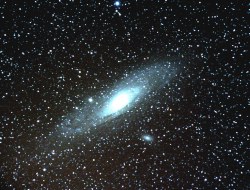
M31 taken on nights of 27th & 28th November 2008 by John Murphy. Canon 350D and 70-300mm Sigma lens piggybacked on C8N-GT. Approx 45 mins total exposure. Nova M31N 2008-11b is just about visible in this shot. ('Nova M31N 2008-11b' subsequently turned out not to be a nova in M31 but some other type of variable star).

Sketch of M51 showing the spiral arms by Deirdre Kelleghan. 6th April 2008. 51cm reflector, 96x at the Cosmos Star Party, Tullamore, Co Offaly.
CCD image of M82. Sum of three 1-min, one 2-min, two 3-min and one 5-min exposures (equivalent of 16-min exposure). Dark frames subtracted from each image. No flat fielding. Summed image processed using the DDP and High Pass FFT filters in Astroart 2.0. Final tweaking with adjustments to brightness/contrast. Autoguiding by STAR2000 module in conjuction with Stalight-Xpress MX516 CCD camera. The images were taken by Gary Nugent at prime focus of the 20cm f/9 Vixen reflector. 2000 Dec. 7 at 00.30 UT.
Finest Globular in the Northern Skies. Taken by John O'Neill with a ST-7 CCD Camera on a 130mm refractor. (10 second exposure).
An 8th Magnitude Globular in Lyra. Taken by John O'Neill with a ST-7 CCD Camera on a 130mm refractor. (30 second exposure). Full Moon and direct light pollution present!
The Pleiades or Seven Sisters. Taken by John Murphy with a Canon 350D DSLR (unmodified) on a 20cm reflector (C8-NGT). Location: Wexford Town. 28th Dec. 2008.
Left: CCD image of the Trapezium area of M42. Focussing not pin point (cf. M82; using same equipment). This image is an average of three three-minute autoguided exposures. Processed with DDP, Unsharp Masking and High Pass FFT filters. No dark frames or flat fielding applied. Taken by Gary Nugent. 2000 Dec. 6 at 22.30 UT.
Middle: Pencil Drawing by Deirdre Kelleghan on January 8/9 2006.
Right: Image taken by John Murphy with a Canon 350D DSLR (unmodified) on a 20cm reflector (C8-NGT). Location: Wexford Town. 27th Dec. 2008. North is up.
Colour images of M27 in Vulpecula by John Murphy:
Left: 30th Aug 2008 between 01:30 and 03:30. Unmodified Canon 350D Camera with a 20cm Celestron C8N-GT Telescope. 5 x 30 second exposures.
Right: Shot during September 2008. Equipment used Canon 350D, 20cm Celestron C8N-GT Telescope, prime focus. Total exposure time 22.5 mins (45x30 sec). This image is featured on the Sky at Night CD December 2008 issue.
Left: Thirty selected 20-second exposures of M57 through the 20cm Vixen reflector on Aug. 1st which was running at f/6.3 with a focal reducer.
Stacked in AstroArt to get the equivalent of a 10-minute exposure, then passed through a Richardson-Lucy Deconvolution filter in AIP4WIN and exported to PhotoShop where final tweaking of contrast, brighthess and unsharp masking was done.
As you can see, a satellite travelled close to M57 during one of the exposures. After processing, some filamentary structure of the Planetary has become apparent and the mag. 14 central star is very apparent. If you look to the right fo the bright star at lower left, there's another less bright star at about the 4 O'Clock position from it. Just above and to the right of this star is a faint patch of brightness. This is galaxy IC 1296. It shows up better on the original image but almost disappears when the background is darkened to an acceptable aesthetic level. Taken by Gary Nugent.
Centre: The most famous planetary nebula in the skies. Even with this short 10 second exposure the central star can be made out. Taken by John O'Neill with a ST-7 CCD Camera on a 130mm refractor.
Right: Colour image of M57 by John Murphy on 30th August 2008 between 01:30 and 03:30. Unmodified Canon 350D Camera with a 20cm Celestron C8N-GT Telescope. 5 x 30 second exposures.